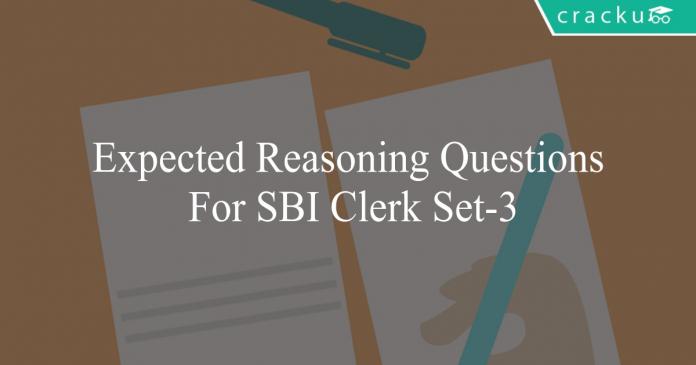Expected Reasoning Questions For SBI Clerk Set-3
Download SBI Clerk Expected Reasoning Questions & Answers PDF for SBI Clerk Prelims and Mains exam. Very Important SBI Clerk Expected Reasoning questions with solutions.
Download Expected Reasoning Questions For SBI Clerk Set-3
790+ Mocks – Just Rs. 194. Use coupon: SBIDREAM70
Download SBI Clerk Important Q&A PDF
Question 1: 7 : 51 :: 5 : ?
a) 23
b) 24
c) 25
d) 27
e) 31
Question 2: duck : duckling :: lion : ?
a) puppy
b) kitten
c) cub
d) chicken
e) tiger
Question 3: Playing : Piano :: ? : Keyboard
a) typing
b) learning
c) inputing
d) printing
e) writing
Download SBI Clerk Previous Papers PDF
Take a free mock test for SBI Clerk
Question 4: Glass : Window :: ? : Table
a) chair
b) room
c) wood
d) seat
e) fan
Question 5: Income is related to profit in the same way as Expenditure is related to
a) Loss
b) Surphis
c) Balance
d) Sale
e) Steal
Instructions
9 people from A-I lives in building with 3 floors floor 1, floor 2 and floor 3. The houses are 1A, 1B, 1C, 2A, 2B, 2C, 3A, 3B and 3C in such a was that 3A is just above 2A, which in turn is just above 1A. Same is true for series B and C. The following information is known:-
A lives on 3rd floor. D lives in a B house. C and B live on the same floor. A and B live in the flat with the same letter. The same is true for C and E. F live in 1A house. E lives on a floor above G whereas G lives on a floor above I.
Question 6: Who among the following is living in a B house?
a) A
b) C
c) H
d) I
e) Cannot be determined
Question 7: If H and I live in the same letter house, then who lives in 1B?
a) B
b) C
c) I
d) D
e) Cannot be determined
Banking Study Material – 18000 Questions
Question 8: For how many people we can determine the floor they live in?
a) 9
b) 7
c) 6
d) 5
e) None of the above
Instructions
7 friends Abhay, Bhushan, Conan, Divya, Esha, Fawad and Gillespi have a different number of cars with them one among 1, 2, 3, 4, 5, 6 and 7 not necessarily in that order. The number of cars with Abhay is a prime number. The number of cars with Bhushan is more than the number of cars with Gillespi. The number of friends with more car then Conan is the same as the number of people with fewer cars than him. The number of cars with Esha is an even number less than 6. The number of cars with Fawad is the average of the number of cars with Abhay and Divya. The number of cars with Divya is a perfect square.
Question 9: How many people have more number of cars than Abhay?
a) 5
b) 4
c) 2
d) 0
e) Cannot be determined
Question 10: What is the number of cars with Gillespi?
a) 3
b) 5
c) 6
d) 4
e) 2
Instructions
In the following question three statements are given, followed by two conclusions. You have to consider the statements to be true even if they seem to be at variance from commonly known facts. You have to decide which of the given conclusions, if any, follows from the given statements and select the appropriate option.
Question 11: Statement I: All crows are black
Statement II: Some pigeons are black
Statement III: Some pigeons are bats
Conclusion I: All crows can be pigeons
Conclusion II: All bats can be black
a) Conclusion I only
b) Conclusion II only
c) Both the conclusions follow
d) Either conclusion I or conclusion II follows
e) None of the conclusions follows
Question 12: Statement I: All batsmen are wicket keepers
Statement II: No wicket keeper is a bowler
Statement III: All bowlers are all rounders
Conclusion I: All batsmen being all rounders is not a possibility
Conclusion II: No wicket keeper is an all rounder
a) Conclusion I only
b) Conclusion II only
c) Both the conclusions follow
d) Either conclusion I or conclusion II follows
e) None of the conclusions follows
Question 13: Statement I: Some pins are blades
Statement II: All steels are stainless
Statement III: Some blades are steel
Conclusion I: All blades can be stainless
Conclusion II: All pins cannot be stainless
a) Conclusion I only
b) Conclusion II only
c) Both the conclusions follow
d) Either conclusion I or conclusion II follows
e) None of the conclusions follows
Instructions
In the following question three statements are given, followed by two conclusions. You have to consider the statements to be true even if they seem to be at variance from commonly known facts. You have to decide which of the given conclusions, if any, follows from the given statements and select the appropriate option.
Question 14: Statement I: Some spheres are cubes.
Statement II: No cube is a cuboid.
Statement III: All cuboids are cones.
Conclusion I: No cone is a sphere.
Conclusion II: No cube is a cone.
a) Conclusion I only
b) Conclusion II only
c) Both the conclusions follow
d) Either conclusion I or conclusion II follows
e) None of the conclusions follows
Question 15: Statement I: Some carrots are radishes.
Statement II: No radish is a tomato.
Statement III: All tomatoes are potatoes.
Conclusion I: Some carrots are tomatoes.
Conclusion II: All radishes can be carrots.
a) Conclusion I only
b) Conclusion II only
c) Both the conclusions follow
d) Either conclusion I or conclusion II follows
e) None of the conclusions follows
Instructions
Find the missing number (?) in the given series from the options provided.
Question 16: 2, 4, 7, 11, 16, ?
a) 22
b) 21
c) 20
d) 23
e) 24
Question 17: 9, 27, 45, 63, ?
a) 79
b) 80
c) 81
d) 82
e) 83
Question 18: 3, 8, 15, 24, 35, ?
a) 63
b) 49
c) 80
d) 48
e) 56
Question 19: -3, -1, 11, 39, 89, ?
a) 198
b) 189
c) 210
d) 174
e) 167
Question 20: 9, 12, 19, 34, 65, ?
a) 127
b) 128
c) 129
d) 130
e) 134
General Knowledge Questions & Answers PDF
Answers & Solutions:
1) Answer (D)
51 = $7^2$ + 2
So, the required number is $5^2$ + 2 = 27
2) Answer (C)
A duckling is the young one of a duck and a cub is the young one of a lion. So, the answer is c) cub.
3) Answer (A)
A piano is used for playing and a keyboard is used for typing. So, the correct answer is option a).
4) Answer (C)
A window is made of glass and a table is made of wood. So, wood is the correct answer.
5) Answer (A)
Income is considered Profit; Similarly, Expenditure is considered Loss.
6) Answer (E)
A lives on 3rd floor.
E lives on a floor above G whereas G lives on a floor above I.
Thus, E lives on 3rd floor, G lives on 2nd floor and I lives on 1st floor.
C and B live on the same floor
Already 2 people live on 3rd floor. Thus, B and C either live on 2nd or 1st floor.
F live in 1A and already I lives on 1st floor.
Thus, B and C must live on 2nd floor.
Thus, F and I live on 1st floor, B, C and G live on 2nd floor and A, E live on 3rd floor.
D and H live in 1st and 3rd floor in any order.
Thus, the table is:-

We cannot determine who lives in a B house without any further information.
Hence, option E is the correct answer.
7) Answer (D)
A lives on 3rd floor.
E lives on a floor above G whereas G lives on a floor above I.
Thus, E lives on 3rd floor, G lives on 2nd floor and I lives on 1st floor.
C and B live on the same floor
Already 2 people live on 3rd floor. Thus, B and C either live on 2nd or 1st floor.
F live in 1A and already I lives on 1st floor.
Thus, B and C must live on 2nd floor.
Thus, F and I live on 1st floor, B, C and G live on 2nd floor and A, E live on 3rd floor.
D and H live in 1st and 3rd floor in any order.
Thus, the table is:-

Thus, if H and I have the same lettered house then they must live on different floors.
Thus, H lives on 3rd floor.
Thus, D must live on 1st floor and more particularly in 1B.
Hence, option D is the correct answer.
8) Answer (B)
A lives on 3rd floor.
E lives on a floor above G whereas G lives on a floor above I.
Thus, E lives on 3rd floor, G lives on 2nd floor and I lives on 1st floor.
C and B live on the same floor
Already 2 people live on 3rd floor. Thus, B and C either live on 2nd or 1st floor.
F live in 1A and already I lives on 1st floor.
Thus, B and C must live on 2nd floor.
Thus, F and I live on 1st floor, B, C and G live on 2nd floor and A, E live on 3rd floor.
D and H live in 1st and 3rd floor in any order.
Thus, the table is:-

Thus, we can determine the floor on which a person lives for 7 people.
Hence, option B is the correct answer.
9) Answer (C)
The number of friends with more car then Conan is the same as the number of people with less cars than him.
Thus, Conan has 4 cars.
The number of cars with Divya is a perfect square. Thus, Divya has either 1 or 4 cars.
But, Conan has 4 cars. Thus, Divya has 1 cars.
The number of cars with Esha is an even number less than 6.
Thus, Esha has 2 cars.
The number of cars with Abhay is a prime number.
Thus, Abhay has 3, 5 or 7 cars.
The number of cars with Fawad is the average of the number of cars with Abhay and Divya.
Thus, the number of cars with Fawad can be 3 or 4.
But, Conan has 4 cars. Thus, Fawad has 3 cars.
Abhay has 5 cars.
The number of cars with Bhushan is more than the number of cars with Gillespi
Thus, Bhushan has 7 cars and Gillespi has 6 cars.
Abhay has 5 cars. Thus, we can say that 2 people have more number of cars than Abhay.
Hence, option C is the correct answer.
10) Answer (C)
The number of friends with more car then Conan is the same as the number of people with less cars than him.
Thus, Conan has 4 cars.
The number of cars with Divya is a perfect square. Thus, Divya has either 1 or 4 cars.
But, Conan has 4 cars. Thus, Divya has 1 cars.
The number of cars with Esha is an even number less than 6.
Thus, Esha has 2 cars.
The number of cars with Abhay is a prime number.
Thus, Abhay has 3, 5 or 7 cars.
The number of cars with Fawad is the average of the number of cars with Abhay and Divya.
Thus, the number of cars with Fawad can be 3 or 4.
But, Conan has 4 cars. Thus, Fawad has 3 cars.
Abhay has 5 cars.
The number of cars with Bhushan is more than the number of cars with Gillespi
Thus, Bhushan has 7 cars and Gillespi has 6 cars.
Hence, option C is the correct answer.
11) Answer (C)

From the diagram, we can see that All crows can be pigeons and All bats can be black.
Hence, option C is the correct answer.
12) Answer (E)

From the diagram, we can see that all batsmen being all rounder is a possibility and some wicket keepers can be all rounders.
Hence, option E is the correct answer.
13) Answer (A)

From the diagram, we can see that all blades can be stainless and all pins can be stainless
Therefore, option A is the correct answer.
14) Answer (E)

From the diagram, we can see that some cones can be spheres. Hence, conclusion I doesn’t follow.
From the diagram, we can see that some cubes can be cones. Hence, conclusion II doesn’t follow.
Therefore, option E is the correct answer.
15) Answer (B)

From the diagram, we can see that no carrot is a tomato. Hence, conclusion I doesn’t follow.
From the diagram, we can see that some all radishes can be carrots. Hence, conclusion II follows.
Therefore, option B is the correct answer.
16) Answer (A)
$\Rightarrow$ $T_{2} – T _{1} = 4 – 2 = 2$
$\Rightarrow$ $T_{3} – T _{2} = 7 – 4 = 3$
$\Rightarrow$ $T_{4} – T _{3} = 11 – 7 = 4$
$\Rightarrow$ $T_{5} – T _{4} = 16 – 11 = 5$
Here we can see the pattern that difference between consecutive terms are in A.P. and it is increasing by 1. Therefore,
$\Rightarrow$ $T_{6} = 6 + T _{5} = 6+16 = 22$
Hence, option A is the correct answer.
17) Answer (C)
$\Rightarrow$ $T_{1} = 9 = 5^2 – 4^2$
$\Rightarrow$ $T_{2} = 27 = 6^2 – 3^2$
$\Rightarrow$ $T_{3} = 45 = 7^2 – 2^2$
$\Rightarrow$ $T_{4} = 63 = 8^2 – 1^2$
Hence, we can say that $\Rightarrow$ $T_{n} = (n+4)^2 – (5-n)^2$
$\Rightarrow$ $T_{5} = (5+4)^2 – (5-4)^2 = 81$
Hence, option C is the correct answer.
18) Answer (D)
$\Rightarrow$ $T_{1} = 3 = 2^2 – 1$
$\Rightarrow$ $T_{2} = 8 = 3^2 – 1$
$\Rightarrow$ $T_{3} = 15 = 4^2 – 1$
$\Rightarrow$ $T_{4} = 24 = 5^2 – 1$
$\Rightarrow$ $T_{5} = 35 = 6^2 – 1$
Hence, we can say that $\Rightarrow$ $T_{n} = (n+1)^2 – 1$
$\Rightarrow$ $T_{6} = (6+1)^2 – 1 = 48$
Hence, option D is the correct answer.
19) Answer (E)
$\Rightarrow$ $T_{1} = -3 = 1^3 – 2^2$
$\Rightarrow$ $T_{2} = -1 = 2^3 – 3^2$
$\Rightarrow$ $T_{3} = 11 = 3^3 – 4^2$
$\Rightarrow$ $T_{4} = 39 = 4^3 – 5^2$
$\Rightarrow$ $T_{5} = 89 = 5^3 – 6^2$
Hence, we can say that $\Rightarrow$ $T_{n} = n^3 – (n+1)^2$
$\Rightarrow$ $T_{6} = 6^3 – 7^2 = 167$
Hence, option E is the correct answer.
20) Answer (B)
$\Rightarrow$ $T_{1} = 9 = 2^2 + 5$
$\Rightarrow$ $T_{2} = 12 = 2^3 + 4$
$\Rightarrow$ $T_{3} = 19 = 2^4 + 3$
$\Rightarrow$ $T_{4} = 34 = 2^5 + 2$
$\Rightarrow$ $T_{5} = 65 = 2^6 + 1$
Hence, we can say that $\Rightarrow$ $T_{n} = 2^{n+1} + (6 -n)$
$\Rightarrow$ $T_{6} = 2^{6+1} + (6 – 6) = 128$
Hence, option B is the correct answer.
We hope this Expected Reasoning Question & Answers PDF of SBI Clerk is very Useful for preparation of SBI Clerk Exams.





